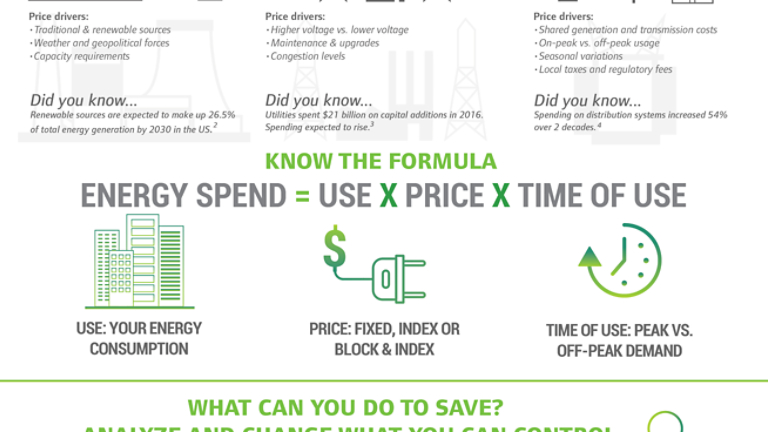The Formula for Energy Supply Management
August 28, 2018
When customers ask for our help in analyzing their energy bill, we start by building a fundamental understanding of the influencing factors. While there are many complexities to the fees that are buried in a typical month energy bill (see our Energy Bill 101 article for more on hidden energy costs), we begin by using this simplified formula. Let’s look at each of these factors.
Energy Spend = Use × Price × Time of Use
Use
How much electricity is consumed by the business? Since this factor is internally driven, it’s the factor that companies can most control. A kilowatt hour (kWh) is a measure of how much energy you’re using. It is a unit of measurement that equals the amount of energy you would use if you kept 1,000 watts, or a kilowatt (kW), running for an hour. . At any given moment, the demand your load is placing on the system can be measured in kilowatts. To get total usage, multiply kilowatts by the total time of usage in hours to arrive at kWh.
kWh can be reduced in two ways:
- Improve efficiency by installing more energy-efficient equipment. HVAC systems and lighting are typically the two biggest energy consumers in a commercial building. According to a study conducted by the American Council for an Energy Efficient Economy[1], the average office building can save 18% of the building’s total energy use through the installation of smart technologies.
- Use equipment and lighting less. Changing system scheduling and set points to better reflect business hours and occupancy trends may substantially reduce consumption without compromising comfort.

Price
In states where electricity is deregulated, parties other than the utility companies are allowed to own power plants and transmission lines and to sell electricity. This increases competition and opens up opportunities for customers to choose their own provider. For these customers, there are generally three different approaches to how electricity is priced. Which plan is best for you depends on your risk tolerance, operational goals and business objectives.
Load-following fixed price. This is the most common form of pricing. It gives the end user the most stable pricing and therefore the lowest budget risk. It also builds in the highest margin for the supplier. Prices remain mostly stable for a fixed length of time, although the supplier may pass through some pricing variables, such as increases in capacity and transmission charges.
100% index pricing. This structure typically has the lowest supplier margin. It also has the greatest market exposure and the highest risk of pricing variability for the end user. Prices are based on day-ahead or real-time market settlements.
Block and index pricing. Based on a combination of fixed pricing and index settlements, this option offers a balance of pricing risk and stability and will also include the load following price components.
Time of Use
The wholesale price of electricity varies based on the real-time demand on the power grid. Demand—and price—are generally highest during the late afternoon hours. Demand varies seasonally as well, peaking during the hot summer months. However, peak demand charges vary both regionally and by utility, so this is one of the first things we investigate. By investigating consumption schedules, we can help develop plans on how to shift load away from the highest-cost hours of use. In addition to load shifting, implementing energy storage, such as thermal or battery storage, enables customers to purchase energy at off-peak rates and store it for use during the more expensive on-peak hours. A study conducted by E3[2] found that customers using permanent load shifting technologies, like energy storage, had peak demand cost avoidances in the range of $500/peak kW to $2,500/peak kW.
Utilities can also offer a ‘Time of Use’ rate option, charging different prices depending on the time of day/season electricity is consumed. These rates can be beneficial if customers can load shift to ‘off-peak hours’. On-peak / off-peak hours can differ by utility and are posted in the tariff. These rates will also depend on the site’s load factor.
If you’d like Trane’s energy procurement specialists to analyze when and how your business is consuming energy, please sign up here to receive a free energy bill analysis.
[1] Source: http://aceee.org/research-report/a1703
[2] Source: https://www.ethree.com/public_proceedings/statewide-joint-iou-study-permanent-load-shifting/
